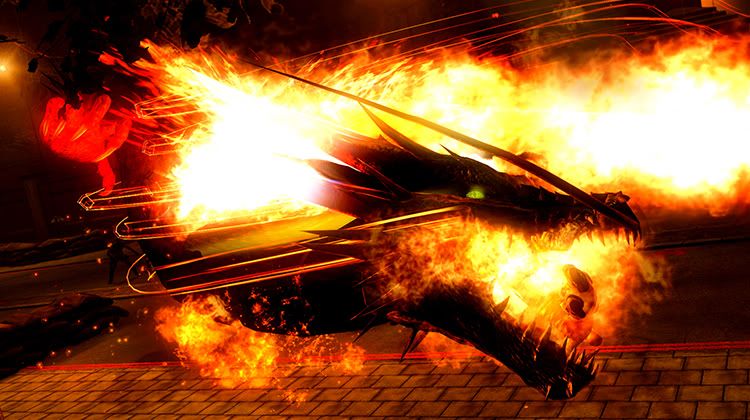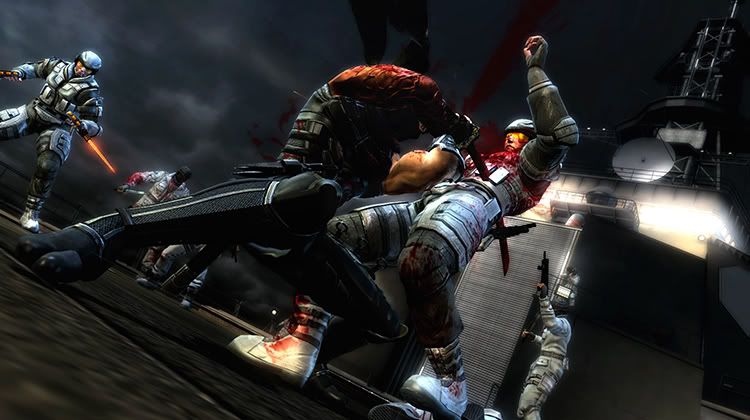
Ever since it’s revival in 2004 on the Xbox, Ninja Gaiden has grown in popularity among gamers as a genre defining action series. While the series is known for its great combat, it is also polarizing gamers with it’s higher than normal challenge and difficulty. Team Ninja has made a number of changes for their latest game Ninja Gaiden 3 in hopes of making it more accessible to gamers. Is this new change in direction successful, or does it do more harm than good?

Ninja Gaiden 3 begins when Ryu Hyabusa, master ninja of the dragon lineage, is asked to assist the Japanese Ministry of Defense in dealing with a group of terrorists that have occupied London. This trip ends up going south as Ryu ends up with a curse that seals his Dragon Sword into his arm and makes him feel the malice and hate of all that he killed over the years. The rest of the plot involves tracking down the group responsible, and stopping their plans for world domination. Ninja Gaiden 3’s story is typical action game fare, and will not win awards. Team Ninja tried to make a more serious plot, and humanize Ryu in considering the morality of his killings. However, it’s rather hard to feel sympathetic when the game has you kill legions of enemies. Seriously by the end of a single playthrough, the in-game kill count for me was just short of 2500.
Fortunately, most people who play Ninja Gaiden play for the action rather than the story. The series ever since it’s 2004 revival on the Xbox is renowned for it’s depth of combat, challenging but fair difficulty, and tight action/gameplay. Ninja Gaiden 3 only hits about half of those marks. The latest game feels stripped down and steamlined compared to its brethren. Gone are the choice of various melee weaponry, gone are the multiple choice in ninpo (ninja magic), and even some basic skills like the guillotine throw have been removed. Ryu is only ever armed with a sword and a single screen clearing ninpo. While the sword still has a fairly extensive movelist, portions of that are not usable until specific story moments in the game; thus early on Ryu is limited in what he can do. Once he has expanded his skillset, combat can become rather fun.
The use of ninpo in Ninja Gaiden 3 is different than before. Rather than have a specific number of uses during a chapter, players will build up a meter with each kill and only when that meter is full can ninpo be utilized. The single ninpo animates nicely a giant fire dragon that gathers all of Ryu enemies and uses them as a snack, and looks cool. Players will be seeing this frequently. This is due to how there are no healing items in the game, and the only way to heal mid-battle is using ninpo. It will be used often, and it does grow old to see after the first level let alone the rest of the game.

Ninja Gaiden 3 also streamlines and tones down the challenge and difficulty that the series is known for. On the default normal difficulty, most of the enemies are simple punching bags that will take Ryu slashes to the face without a thought. It certainly makes the game easier for players to get into. If you are a veteran of the series, you will want to jump right to hard mode as its challenge is almost comparable to normal modes of the other games. Unfortunately, the challenge it provides is not exactly fair this time around. Rather than challenge through balancing offense, defense, and evasion, enemies now take hits to the face and counter attack Ryu during the middle of his attack strings, are insanely grab happy, and will occasionally feel like dodging. Combine that with how Ryu cannot cancel most of combos into an evasive slide to keep himself safe degenerates most encounters into using short 1-2 hit strings hoping to confirm a hit, and sliding away in hopes of not getting grabbed during the long recovery animations.
Encounters throughout the game are also lengthy affairs. The number of enemies you fight at one time has increased to around 8-10 at a time, which is an improvement in the game. However, nearly every fight seems to have a minimum of a dozen or two enemies in total that will spawn as you kill others. The game’s flow results in fighting off a large horde in one room, move to the next room and repeat ad nauseam. As a result, fights become a battle of attrition than anything, and actually can grow tiresome when you consider that the entire game is like this.
Now despite the stripped down aspects of combat, there is still some fun to be had. What started as a roll in the first game and a dash in the second, Ryu’s evasive maneuver of choice in Ninja Gaiden 3 is a slide. Aside from getting him out of harm’s way, the slide can be used offensively as it can stun opponents, and occasionally knock them into the air. This leads into one of the new mechanics: Steel on Bone (SoB). When the enemy is injured, Ryu will initiate a slow motion slice into his foes as the player hits the attack button, until he slices them in half. The feeling of slicing your opposition apart with SoB is incredibly satisfying; even more so when you can chain one into the other in quick succession and clear out large mobs. The only bad thing about SoB is that it can sometimes feel random when trying to get it to activate; so it ends up being somewhat unreliable to use despite how the game seems built around using it.

Team Ninja felt it necessary to include some quicktime event sequences. Some of them like ones during Steel on Bone chains work fine as they involve using buttons that being used at that moment anyway. Then there are the ones where Ryu is climbing a wall or crossing a rope that involve alternating presses of the shoulder buttons. It’s these sequences that are just boring and feel obtrusive to the experience. Even more baffling is when enemies are attacking Ryu during these parts, and he dispatches them with a toss of a kunai. Why is his kunai so effective in killing during these parts, but have the complete opposite effect during real battles?
Aside from the main story, Ninja Gaiden 3 also features a mode titled Shadows of the World. This mode encompasses both the game’s Ninja Trials mode and its online multiplayer. The Ninja Trials mode, which can be played either solo or co-operatively via online, is one of the best parts of the package. Like in previous games, it sets up scenarios of varied enemy combinations and leaves the player to destroy all in his path. Each mission is relatively challenging and places your skills to the test. They become even more enjoyable when played with a partner online (which is pretty much required for the later challenging missions) since one person can revive the other a limited number of times if they die. There is some lag while playing online, but it still runs well enough to get the job done.

On the other hand, the online multiplayer is pretty much slapped together. There is pretty much only a team deathmatch game type, and there are only three playable maps on the disc. It is a shame that they are are incredibly simplistic, small, and not very fun to play on. A lot of matches tend to devolve into mashing attack until you build up ninpo, and then abuse how powerful ninpo is since A) it’s a guaranteed kill on hit, and B) it can travel through walls. Nothing like launching a ninpo in the direction of the other team’s spawn point and get a handful of kills since they could not even see it coming. There seemed to be some promise in the multiplayer, but it falls well short of being something to come back to.
Augmenting both the mission and multiplayer modes is a progression system that’s all too common in games today. Players use a custom ninja for both modes, and earn experience toward unlocking expanded combos and skills. Unfortunately, the design of the progression system here makes things rather imbalanced. Some of the Ninja Trials will feel nearly impossible until players unlock needed skills. The online multiplayer suffers even more as high level players have large advantages since a low level ninja does not have any useful tools to put up a fight.
Graphically, Ninja Gaiden 3 makes some strides over its predecessors. Character models are one of the biggest updates, particularly during a cut scene. Ryu and company no longer look like dolls, and surprisingly most of the female cast has not been overly sexualized in their outfits (though Team Ninja’s trademark large breasts are still in). Environments are hit or miss; while varied, some have nice details that make them stand out, others are bland and uninspired. For each awesome setpiece like fighting across a series of battleships, there’s something uninspired like a large acid pit.
On the audio side of things, Ninja Gaiden 3 is also a mixed bag. Sound effects are spot on. Actively hitting opponents sounds good and makes the player feel the hit, especially the sound of slicing people apart during SoB sequences. Voice samples for enemies are overused and they will repeat frequently during battle. The music this time around is focused on heavy guitar riffs and more of an industrial sound which comes off as generic and not very memorable.
Ultimately, Ninja Gaiden 3 sums up to be just another action game rather than continue to set the bar the series is known for. While it does feel stripped down compared to prior games, it’s core action is still enjoyable to play. The Ninja Trials alone is worth playing, though stay far away from the multiplayer.
|
+ Combat is still fun + Steel on Bone chains are so satisfying + Ninja Trials and co-op is a lot of fun |
|
- Less options available in combat than previous games - Story is largely forgettable - Progression system unbalanced - Multiplayer is outright unfinished |
Final Grade: D+

No comments:
Post a Comment